Life Cycle Analysis of Energy Production from Food Waste through Anaerobic Digestion, Pyrolysis and Integrated Energy System
Abstract
:1. Introduction
2. Materials and Methods
2.1. Scope of the Analysis and Functional Unit
2.2. Scope of the Analysis and Functional Unit
2.3. EOL Management Scenarios Description
2.3.1. Anaerobic Digestion Process
2.3.2. Pyrolysis Treatment Process
2.3.3. Integrated Treatment Process
2.4. Life Cycle Inventory
2.5. Cut-off Criteria
- i
- Materials: In this study, flows lower than 1% of the cumulative mass of the inputs and outputs are excluded due to their environmental irrelevance, which predicates on the type of flow of the LCI. However, this sum of the neglected material flows does not exceed 5% of the mass, energy or environmental relevance.
- ii
- Energy: Flows <1% of the cumulative energy of all the inputs and outputs (depending on the type of flow) of the LCI model, are excluded from this analysis. Their environmental relevance is equally not a concern.
3. Results and Discussion
3.1. Case A: Anaerobic Digestion (AD)
3.2. Case B: Pyrolysis
3.3. Case C: Integrated system
3.4. Comparison of the Analyzed EOL Management Scenarios
4. Conclusions
Acknowledgment
Author Contributions
Conflicts of Interest
Nomenclature
| EOL: End of Life |
| LCA: Life Cycle Assessment |
| LCI: Life Cycle Inventory |
| CC: Climate Change |
| OD: Ozone Depletion |
| TA: Terrestrial Acidification |
| FE: Fresh water Eutrophication |
| ME: Marine Eutrophication |
| HTox: Human Toxicity |
| POF: Photochemical Oxidant Formation |
| PMF: Particulate Matter Formation |
| TEcox: Terrestrial Ecotoxicity |
| FEcox: Fresh water Ecotoxicity |
| MEcox: Marine Ecotoxicity |
| WD: Water Depletion |
| MD: Minerals Depletion |
| FD: Fossil fuel Depletion |
| AD: Anaerobic Digestion |
| MSW: Municipal Solid Waste |
| CHP: Combine Heat and Power |
References
- Edwards, J.; Othman, M.; Burn, S. A review of policy drivers and barriers for the use of anaerobic digestion in Europe, the United States and Australia. Renew. Sustain. Energy Rev. 2015, 52, 815–828. [Google Scholar] [CrossRef]
- Wang, X.; Guo, F.; Li, Y.; Yang, X. Effect of pretreatment on microalgae pyrolysis: Kinetics, biocrude yield and quality, and life cycle assessment. Energy Convers. Manag. 2017, 132, 161–171. [Google Scholar] [CrossRef]
- Ling-Chin, J.; Roskilly, A.P. A comparative life cycle assessment of marine power systems. Energy Convers. Manag. 2016, 127, 477–493. [Google Scholar] [CrossRef]
- Evangelisti, S.; Lettieri, P.; Borello, D.; Clift, R. Life cycle assessment of energy from waste via anaerobic digestion: A UK case study. Waste Manag. 2014, 34, 226–237. [Google Scholar] [CrossRef] [PubMed]
- Vega, G.C.C.; Hoeve, M.T.; Birved, M.; Sommer, S.G.; Bruun, S. Choosing co-substrates to supplement biogas production from animal slurry—A life cycle assessment of the environmental consequences. Bioresour. Technol. 2014, 171, 410–420. [Google Scholar] [CrossRef] [PubMed]
- Wilkinson, K.G. A comparison of the drivers influencing adoption of on-farm anaerobic digestion in Germany and Australia. Biomass Bioenergy 2011, 35, 1613–1622. [Google Scholar] [CrossRef]
- Al Seadi, T.; Lukehurst, C. Quality Management of Digestate from Biogas Plants Used as Fertiliser. IEA Bioenergy, 2012. Available online: http://task37.ieabioenergy.com/files/daten-redaktion/download/publi-task37/Digestate_Brochure_Revised_12-2010.pdf (accessed on 4 December 2015).
- Alburquerque, J.A.; de la Fuente, C.; Ferrer-Costa, A.; Carrasco, L.; Cegarra, J.; Abad, M.; Bernal, M.P. Assessment of the fertiliser potential of digestates from farm and agroindustrial residues. Biomass Bioenergy 2012, 40, 181–189. [Google Scholar] [CrossRef]
- Li, Y.; Park, S.Y.; Zhu, J. Solid-state anaerobic digestion for methane production from organic waste. Renew. Sustain. Energy Rev. 2011, 15, 821–826. [Google Scholar] [CrossRef]
- Alburquerque, J.; de la Fuente, C.; Canpoy, M.; Carrasco, L.; Nájerab, I.; Baixauli, C.; Caravaca, F.; Roldán, A.; Cegarra, J.; Bernal, M.P. Agricultural use of digestate for horticultural crop production and improvement of soil properties. Eur. J. Agron. 2012, 43, 119–128. [Google Scholar] [CrossRef]
- Tambone, F.; Scaglia, B.; D'Imporzano, G.; Schievano, A.; Orzi, V.; Salati, S.; Adani, F. Assessing amendment and fertilizing properties of digestates from anaerobic digestion through a comparative study with digested sludge and compost. Chemosphere 2010, 81, 577–583. [Google Scholar] [CrossRef] [PubMed]
- Monlau, F.; Sambusiti, C.P.; Antoniou, N.; Barakat, A.; Zabaniotou, A. A new concept for enhancing energy recovery from agricultural residues by coupling anaerobic digestion and pyrolysis process. Appl. Energy 2015, 148, 32–38. [Google Scholar] [CrossRef]
- Opatokun, S.A.; Strezov, V.; Kan, T. Product based evaluation of pyrolysis of food waste and its digestate. Energy 2015, 92, 349–354. [Google Scholar] [CrossRef]
- Bogusz, A.; Oleszczuk, P.; Dobrowolski, R. Application of laboratory prepared and commercially available biochars to adsorption of cadmium, copper and zinc ions from water. Bioresour. Technol. 2015, 196, 540–549. [Google Scholar] [CrossRef] [PubMed]
- Cely, P.; Gascó, G.; Paz-Ferreiro, J.; Méndez, A. Agronomic properties of biochars from different manure wastes. J. Anal. Appl. Pyrolysis. 2015, 111, 173–182. [Google Scholar] [CrossRef]
- De Blasio, C.; Järvinen, M. Supercritical Water Gasification of Biomass. In Encyclopedia of Sustainable Technologies; Abraham, M.A., Ed.; Elsevier: Oxford, UK, 2017; pp. 171–195. [Google Scholar]
- Rios, R.; Stragliotto, F. M.; Peixoto, H. R.; Torres, A.E.B.; Bastos-Neto, M.; Azevedo, D.C.S.; Cavalcante, C.L., Jr. Studies on the adsorption behavior of CO2-CH4 mixtures using activated carbon. Braz. J. Chem. Eng. 2013, 30, 939–951. [Google Scholar] [CrossRef]
- Laurent, A.; Bakas, I.; Clavreul, J.; Bernstad, A.; Niero, M.; Gentil, ME.; Hauschild, M.E.; Christensen, T.H. Review of LCA studies of solid waste management systems–Part I: Lessons learned and perspectives. Waste Manag. 2014, 34, 573–588. [Google Scholar] [CrossRef] [PubMed]
- Laurent, A.; Clavreul, J.; Bernstad, A.; Bakas, I.; Niero, M.; Gentil, ME.; Christensen, T.H.; Hauschild, M.E. Review of LCA studies of solid waste management systems–Part II: Methodological guidance for a better practice. Waste Manag. 2014, 34, 589–606. [Google Scholar] [CrossRef] [PubMed]
- Parkes, O.; Lettieri, P.; Bogle, I.D.L. Life cycle assessment of integrated waste management systems for alternative legacy scenarios of the London Olympic Park. Waste Manag. 2015, 40, 157–166. [Google Scholar] [CrossRef] [PubMed]
- Patel, B.; Guo, M.; Izadpanah, A.; Shah, N.; Hellgardt, K. A review on hydrothermal pre-treatment technologies and environmental profiles of algal biomass processing. Bioresour. Technol. 2016, 199, 288–299. [Google Scholar] [CrossRef] [PubMed]
- López-Sabirón, A.M.; Royo, P.; Ferreira, V.J.; Aranda-Usón, A.; Ferreira, G. Carbon footprint of a thermal energy storage system using phase change materials for industrial energy recovery to reduce the fossil fuel consumption. Appl. Energy 2014, 135, 616–624. [Google Scholar] [CrossRef]
- Morero, B.; Rodriguez, M.B.; Campanella, E.A. Environmental impact assessment as a complement of life cycle assessment. Case study: Upgrading of biogas. Bioresour. Technol. 2015, 190, 402–407. [Google Scholar] [CrossRef] [PubMed]
- Gnansounou, E.; Vaskan, P.; Pachón, E.R. Comparative techno-economic assessment and LCA of selected integrated sugarcane-based biorefineries. Bioresour. Technol. 2015, 196, 364–375. [Google Scholar] [CrossRef] [PubMed]
- Rebitzer, G.; Ekvall, T.; Frischknecht, R.; Hunkeler, D.; Norris, G.; Rydberg, T.; Schmidt, W.P.; Suh, S.; Weidema, B.P.; Pennington, D.W. Life cycle assessment: Part 1: Framework, goal and scope definition, inventory analysis, and applications. Environ. Int. 2004, 30, 701–720. [Google Scholar] [CrossRef] [PubMed]
- PRé Consultants. SimaPro 7 LCA software. 2010. Available online: https://www.pre-sustainability.com/simapro (accessed on 4 March 2016).
- Goedkoop, M.; Heijungs, R.; Huijbregts, M.; Schryver, A.D.; Struijs, J.; van Zelm, R. A Life Cycle Impact Assessment Method Which Comprises Harmonised Category Indicators at the Midpoint and the Endpoint Level, Report I: Characterisation; Ministry of Housing, Spatial Planning and Environment: Amsterdam, The Netherlands, 2009.
- Opatokun, S.A.; Kan, T.; Al Shoaibi, A.; Srinivasakannan, C.; Strezov, V. Characterization of Food Waste and Its Digestate as Feedstock for Thermochemical Processing. Energy Fuels 2015, 30, 1589–1597. [Google Scholar] [CrossRef]
- Origin Energy. Elecricity Generation across Austrialia. 2015. Available online: https://www.originenergy.com.au/blog/about-energy/energy-in-australia.html (accessed on 29 January 2016).
- Cao, Y.; Pawłowski, A. Sewage sludge-to-energy approaches based on anaerobic digestion and pyrolysis: Brief overview and energy efficiency assessment. Renew. Sustain. Energy Rev. 2012, 16, 1657–1665. [Google Scholar] [CrossRef]
- Viotti, P.; Di Genova, P.; Falcioli, F. Numerical analysis of the anaerobic co-digestion of the organic fraction from municipal solid waste and wastewater: Prediction of the possible performances at Olmeto plant in Perugia (Italy). Waste Manag. Res. 2004, 22, 115–128. [Google Scholar] [CrossRef] [PubMed]
- Weidema, B.P.; Bauer, C.; Hischier, R.; Mutel, C.; Nemecek, T.; Reinhard, J.; Vadenbo, C.O.; Wernet, G. Overview and Methodology: Data Quality Guideline for the Ecoinvent Database Version 3; Swiss Centre for Life Cycle Inventories: St Gallen, Switzerland, 2013. [Google Scholar]
- Rajaeifar, M.A.; Tabatabaei, M.; Ghanavati, H.; Khoshnevisan, B.; Rafiee, S. Comparative life cycle assessment of different municipal solid waste management scenarios in Iran. Renew. Sustain. Energy Rev. 2015, 51, 886–898. [Google Scholar] [CrossRef]
- Schott, A.B.S.; Andersson, T. Food waste minimization from a life-cycle perspective. J. Environ. Manag. 2015, 147, 219–226. [Google Scholar] [CrossRef] [PubMed]
- Xu, C.; Shi, W.; Hong, J.; Zhang, F.; Chen, W. Life cycle assessment of food waste-based biogas generation. Renew. Sustain. Energy Rev. 2015, 49, 169–177. [Google Scholar] [CrossRef]
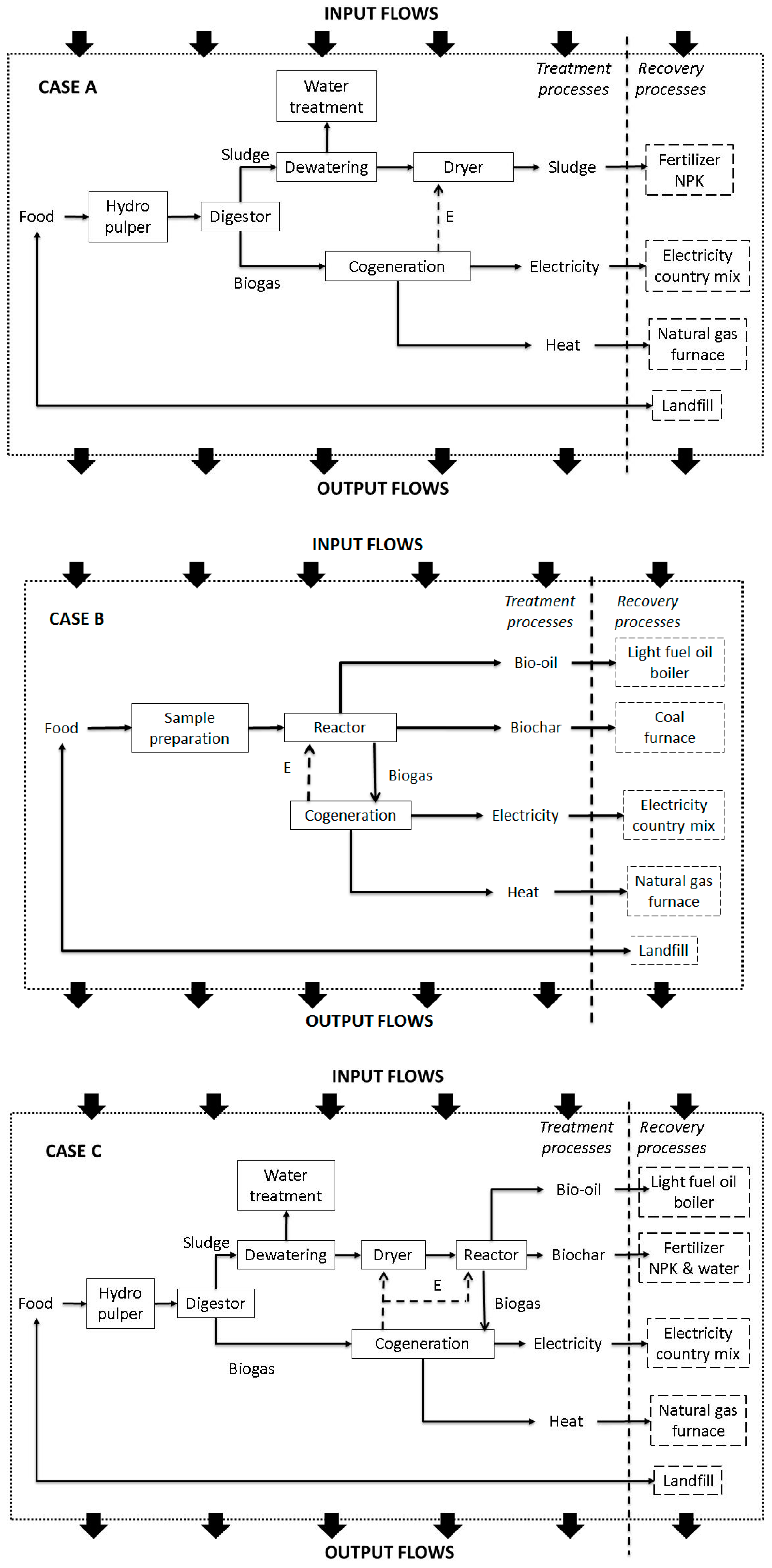
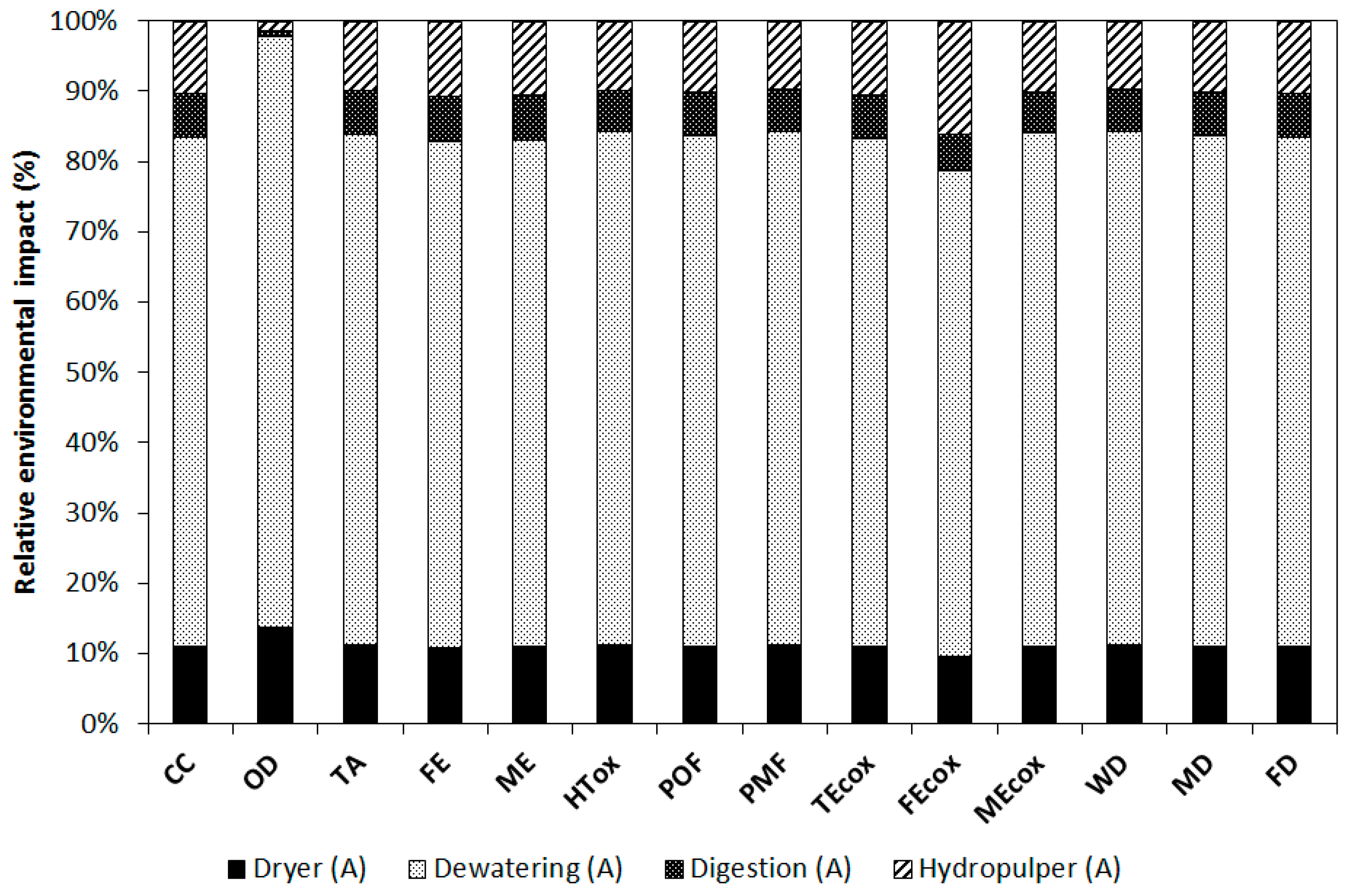
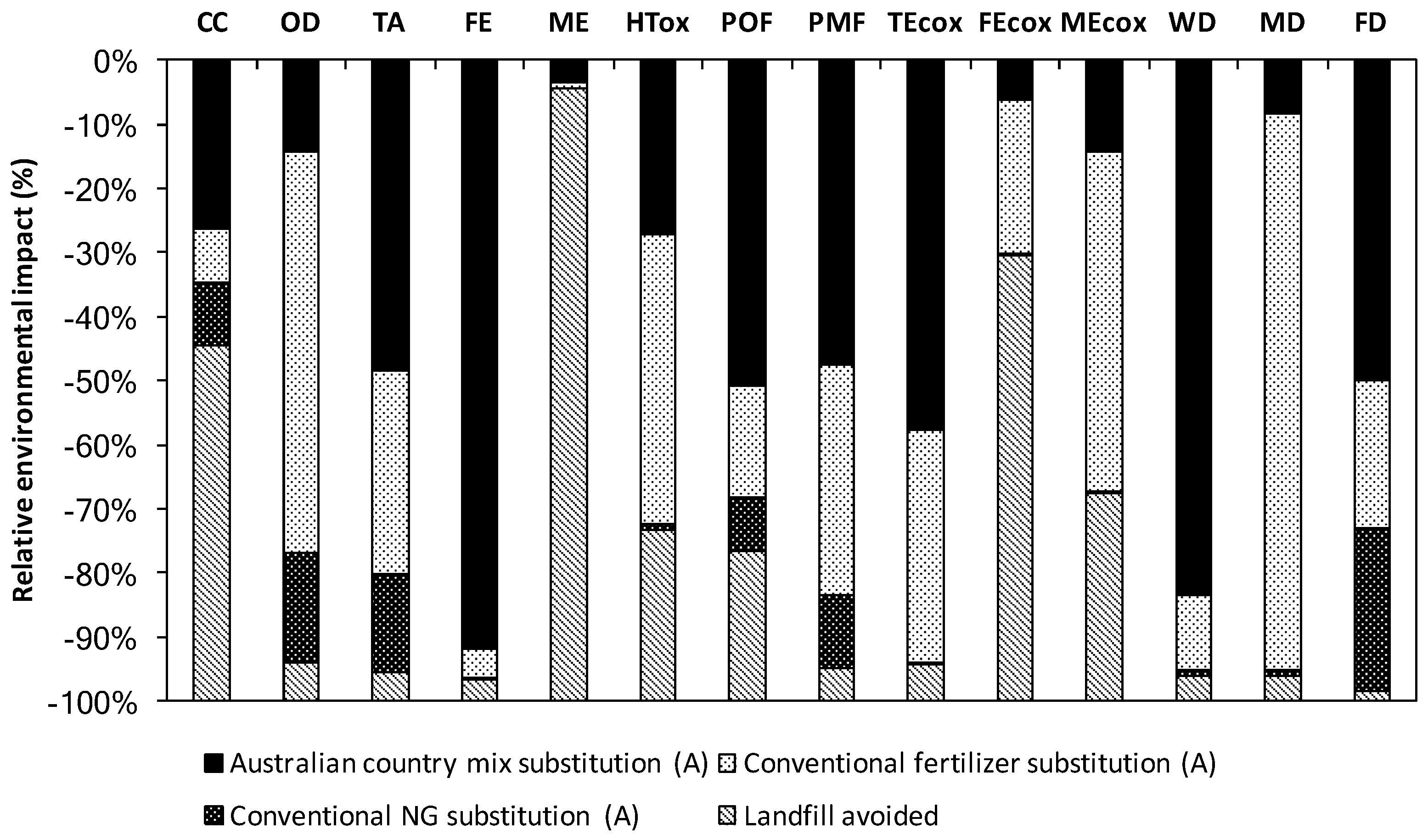
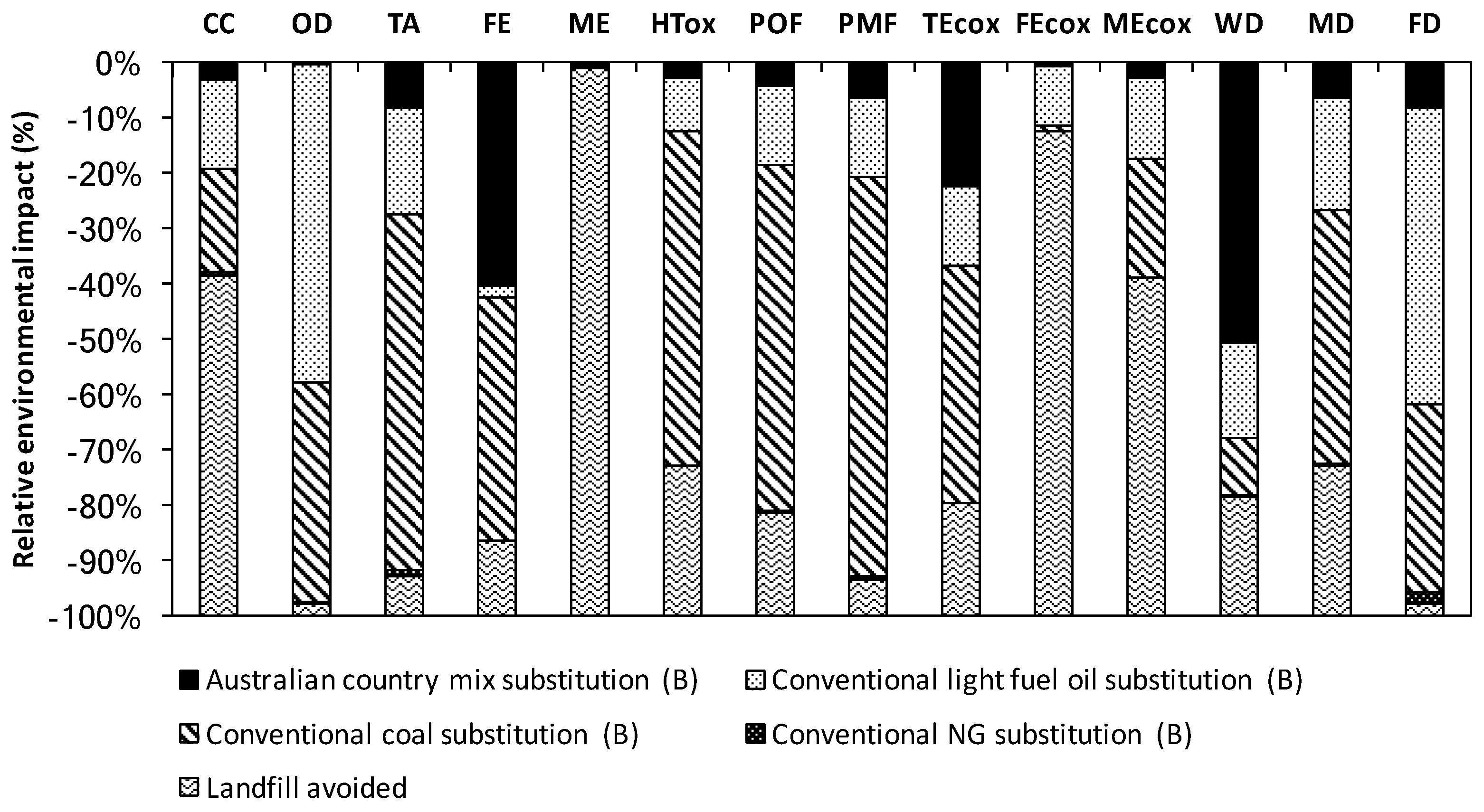
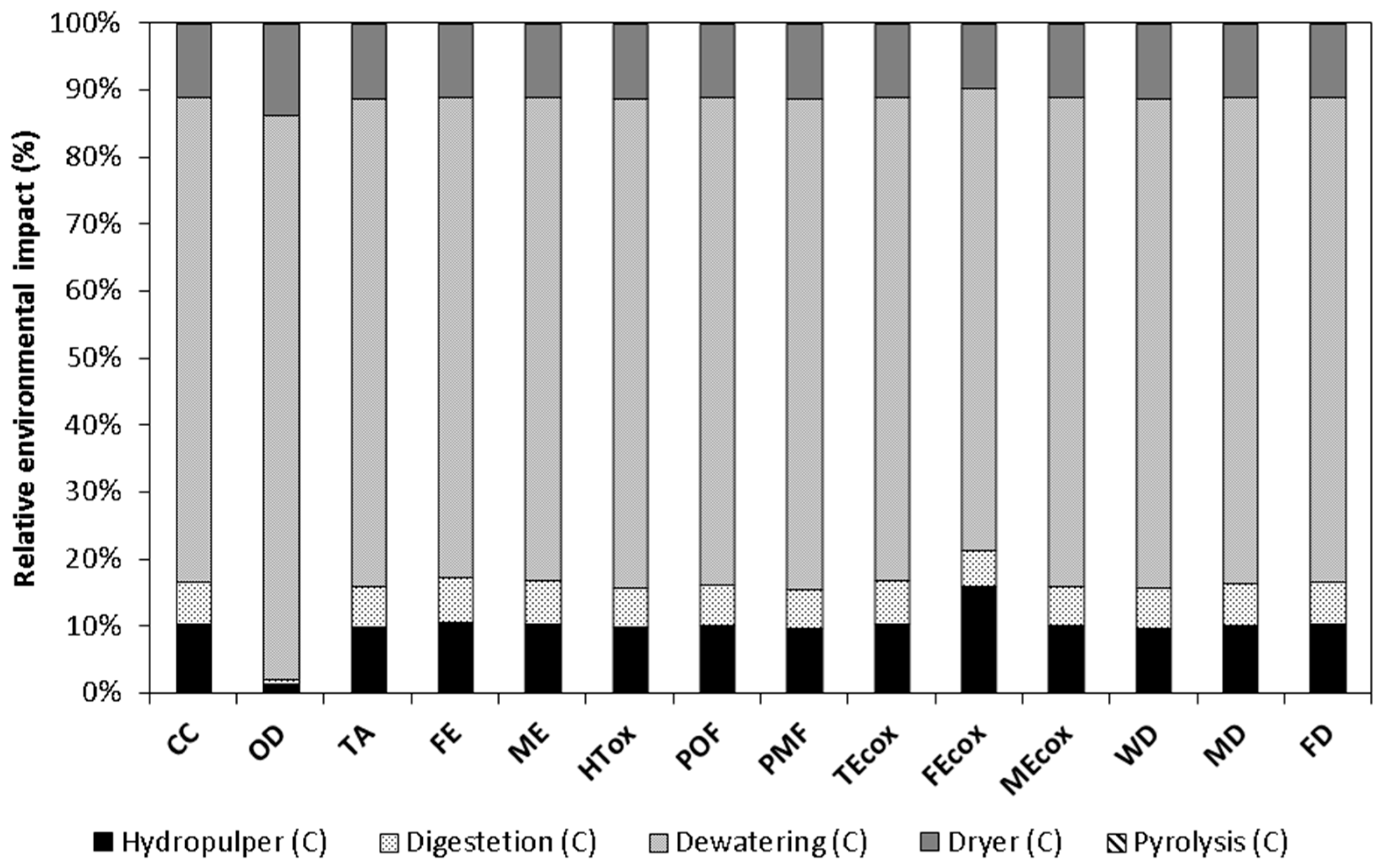
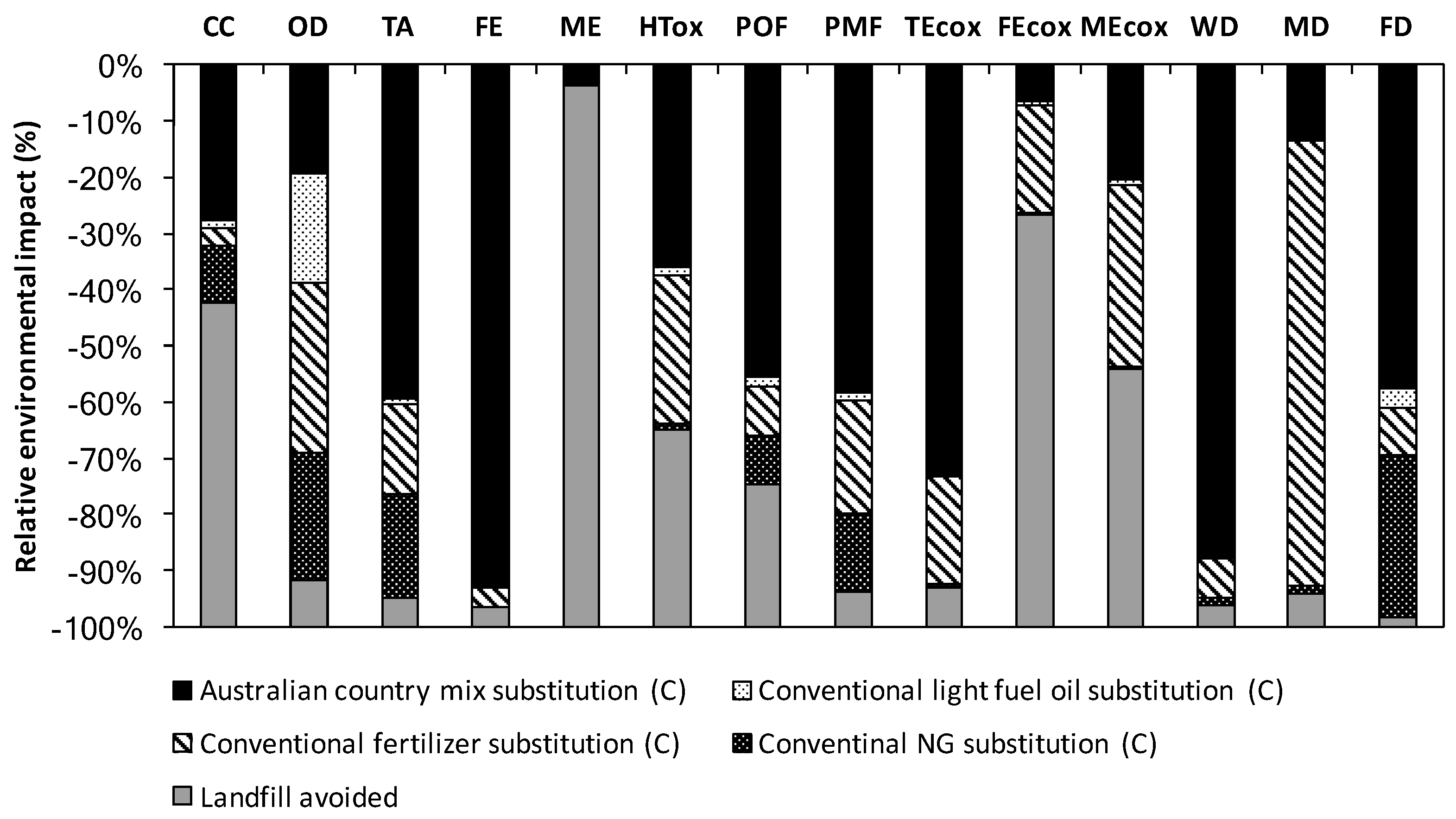
| Main Inputs | Main Outputs | |||
|---|---|---|---|---|
| CASE A | Food waste | 1 kg | Electricity from biogas (CHP) | 0.240 kWh |
| Water | 0.569 kg | Heat * | 0.369 kWh | |
| Electricity | 0.008 kWh | Organic fertilizer | 0.030 kg | |
| Caustic soda | 0.005 kg | |||
| CASE B | Electricity from biogas (CHP) | 0.026 kWh | ||
| Food waste | 1 kg | Heat * | 0.020 kWh | |
| Biochar | 0.097 kg | |||
| Bio-oil | 0.181 kg | |||
| CASE C | Food waste | 1 kg | Electricity from biogas (CHP) | 0.242 kWh |
| Water | 0.569 kg | Heat * | 0.365 kWh | |
| Electricity | 0.136 kWh | Biochar | 0.013 kg | |
| Caustic soda | 0.005 kg | Bio-oil | 0.016 kg | |
| Impact Category | Unit | AD Treatment Process | Use of By-products and Avoided Landfill | Total |
|---|---|---|---|---|
| Climate change | g CO2 eq | 144.22 | −901.38 | −757.16 |
| Ozone depletion | µg CFC-11 eq | 4.79 | −5.24 | −0.45 |
| Terrestrial acidification | g SO2 eq | 0.57 | −1.90 | −1.33 |
| Fresh water eutrophication | g P eq | 0.22 | −0.42 | −0.21 |
| Marine eutrophication | g N eq | 0.06 | −2.94 | −2.88 |
| Human toxicity | g 1,4-DB eq | 2.33 | −12.85 | −10.52 |
| Photochemical oxidant formation | g NMVOC | 0.34 | −1.10 | −0.75 |
| Particle matter formation | g PM10 eq | 0.17 | −0.56 | −0.39 |
| Terrestrial ecotoxicity | g 1,4-DB eq | 0.01 | −0.03 | −0.02 |
| Fresh water ecotoxicity | g 1,4-DB eq | 0.01 | −0.18 | −0.17 |
| Marine ecotoxicity | g 1,4-DB eq | 0.02 | −0.22 | −0.20 |
| Water depletion | l | 327.29 | −918.85 | −591.56 |
| Minerals depletion | g Fe eq | 0.50 | −0.99 | −0.49 |
| Fossil fuel depletion | g oil eq | 37.55 | −125.48 | −87.94 |
| Impact Category | Unit | Pyrolysis Treatment Process | Use of By-products and Avoided Landfill | Total |
|---|---|---|---|---|
| Climate change | g CO2 eq | 683.11 | −809.08 | −125.97 |
| Ozone depletion | µg CFC-11 eq | 2.82 | −14.63 | −11.82 |
| Terrestrial acidification | g SO2 eq | 2.61 | −1.19 | 1.43 |
| Fresh water eutrophication | g P eq | 1.07 | −0.10 | 0.96 |
| Marine eutrophication | g N eq | 0.29 | −2.84 | −2.56 |
| Human toxicity | g 1,4-DB eq | 10.27 | −12.59 | −2.32 |
| Photochemical oxidant formation | g NMVOC | 1.59 | −1.39 | 0.20 |
| Particle matter formation | g PM10 eq | 0.76 | −0.45 | 0.31 |
| Terrestrial ecotoxicity | g 1,4-DB eq | 0.04 | −0.01 | 0.03 |
| Fresh water ecotoxicity | g 1,4-DB eq | 0.03 | −0.14 | −0.11 |
| Marine ecotoxicity | g 1,4-DB eq | 0.10 | −0.12 | −0.02 |
| Water depletion | l | 1457.88 | −164.09 | 1293.79 |
| Minerals depletion | g Fe eq | 2.32 | −0.14 | 2.18 |
| Fossil fuel depletion | g oil eq | 178.34 | −81.38 | 96.97 |
| Impact Category | Unit | Integrated Treatment Process | Use of By-products and Avoided Landfill | Total |
|---|---|---|---|---|
| Climate change | g CO2 eq | 144.22 | −865.66 | −721.44 |
| Ozone depletion | µg CFC-11 eq | 4.79 | −3.88 | 0.91 |
| Terrestrial acidification | g SO2 eq | 0.57 | −1.57 | −1.00 |
| Fresh water eutrophication | g P eq | 0.22 | −0.42 | −0.21 |
| Marine eutrophication | g N eq | 0.06 | −2.92 | −2.87 |
| Human toxicity | g 1,4-DB eq | 2.33 | −9.74 | −7.41 |
| Photochemical oxidant formation | g NMVOC | 0.34 | −1.01 | −0.67 |
| Particle matter formation | g PM10 eq | 0.17 | −0.46 | −0.29 |
| Terrestrial ecotoxicity | g 1,4-DB eq | 0.01 | −0.02 | −0.01 |
| Fresh water ecotoxicity | g 1,4-DB eq | 0.01 | −0.17 | −0.16 |
| Marine ecotoxicity | g 1,4-DB eq | 0.02 | −0.16 | −0.14 |
| Water depletion | l | 327.29 | −882.02 | −554.73 |
| Minerals depletion | g Fe eq | 0.50 | −0.64 | −0.14 |
| Fossil fuel depletion | g oil eq | 37.55 | −110.17 | −72.63 |
| Impact Category | Unit | Case A | Case B | Case C | Landfill |
|---|---|---|---|---|---|
| Climate change | g CO2 eq | −757.16 | −125.97 | −721.44 | 498.27 |
| Ozone depletion | µgCFC-11 eq | −0.45 | −11.82 | 0.91 | 0.32 |
| Terrestrial acidification | g SO2 eq | −1.33 | 1.43 | −1.00 | 0.08 |
| Fresh water eutrophication | g P eq | −0.21 | 0.96 | −0.21 | 0.01 |
| Marine eutrophication | g N eq | −2.88 | −2.56 | −2.87 | 2.81 |
| Human toxicity | g1,4-DB eq | −10.52 | −2.32 | −7.41 | 3.41 |
| Photochemical oxidant formation | g NMVOC | −0.75 | 0.20 | −0.67 | 0.26 |
| Particle matter formation | g PM10 eq | −0.39 | 0.31 | −0.29 | 0.03 |
| Terrestrial ecotoxicity | g1,4-DB eq | −0.02 | 0.03 | −0.01 | 0.00 |
| Fresh water ecotoxicity | g1,4-DB eq | −0.17 | −0.11 | −0.16 | 0.12 |
| Marine ecotoxicity | g1,4-DB eq | −0.20 | −0.02 | −0.14 | 0.07 |
| Water depletion | l | −591.56 | 1293.79 | −554.73 | 34.98 |
| Minerals depletion | g Fe eq | −0.49 | 2.18 | −0.14 | 0.04 |
| Fossil fuel depletion | g oil eq | −87.94 | 96.97 | −72.63 | 1.86 |
© 2017 by the authors. Licensee MDPI, Basel, Switzerland. This article is an open access article distributed under the terms and conditions of the Creative Commons Attribution (CC BY) license (http://creativecommons.org/licenses/by/4.0/).
Share and Cite
Opatokun, S.A.; Lopez-Sabiron, A.; Ferreira, G.; Strezov, V. Life Cycle Analysis of Energy Production from Food Waste through Anaerobic Digestion, Pyrolysis and Integrated Energy System. Sustainability 2017, 9, 1804. https://doi.org/10.3390/su9101804
Opatokun SA, Lopez-Sabiron A, Ferreira G, Strezov V. Life Cycle Analysis of Energy Production from Food Waste through Anaerobic Digestion, Pyrolysis and Integrated Energy System. Sustainability. 2017; 9(10):1804. https://doi.org/10.3390/su9101804
Chicago/Turabian StyleOpatokun, Suraj Adebayo, Ana Lopez-Sabiron, German Ferreira, and Vladimir Strezov. 2017. "Life Cycle Analysis of Energy Production from Food Waste through Anaerobic Digestion, Pyrolysis and Integrated Energy System" Sustainability 9, no. 10: 1804. https://doi.org/10.3390/su9101804
APA StyleOpatokun, S. A., Lopez-Sabiron, A., Ferreira, G., & Strezov, V. (2017). Life Cycle Analysis of Energy Production from Food Waste through Anaerobic Digestion, Pyrolysis and Integrated Energy System. Sustainability, 9(10), 1804. https://doi.org/10.3390/su9101804






